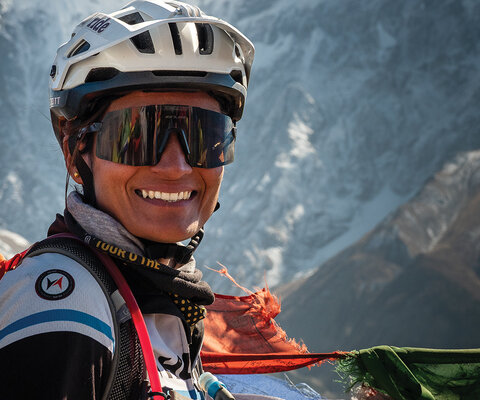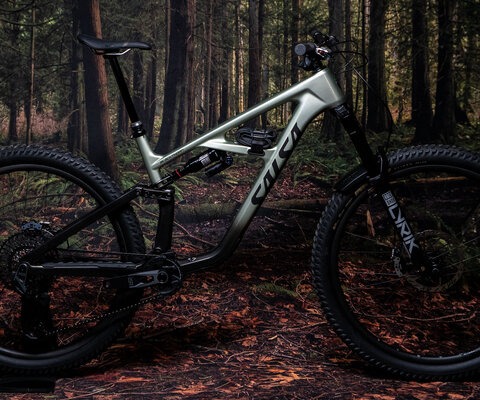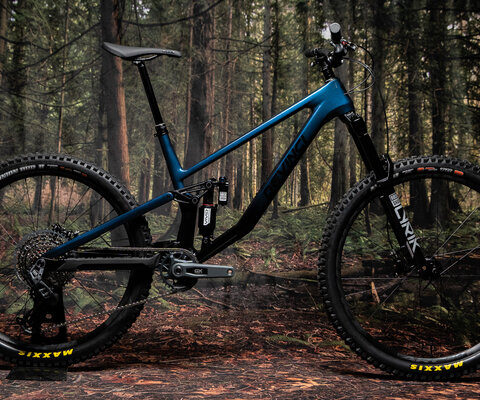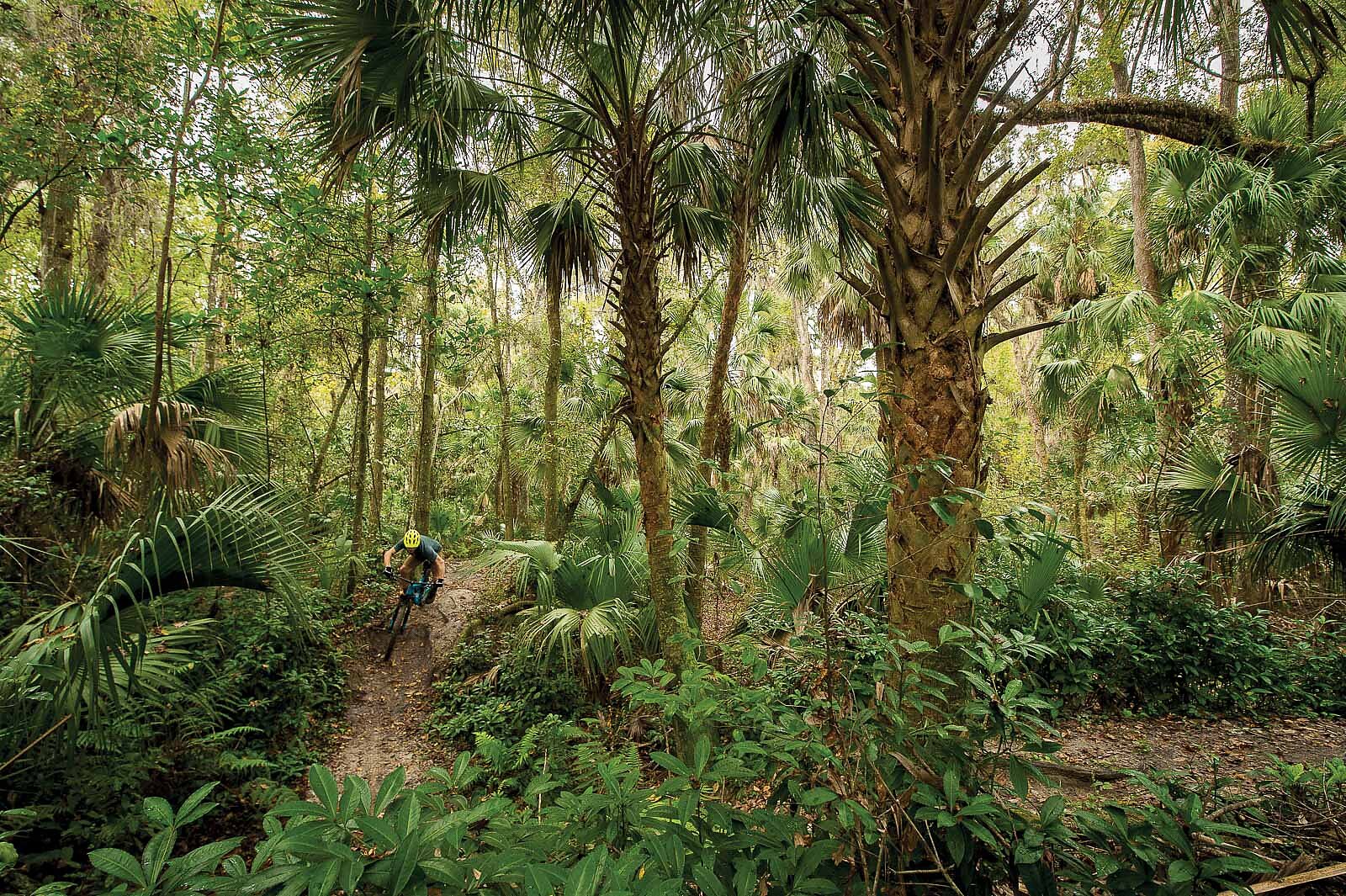
Down and Dirty A Southern Journey for Sun
Words by Alain Denis
It all started with a cold snap at the end of October.
Halloween was only a few days away when the temps began to drop. By the time trick-or-treaters headed into the neighborhoods of our hometown of Sainte-Adele, in the Laurentian Mountains of Quebec, conditions were well below freezing and the forecast showed nothing but snow.
As Quebec natives, neither my wife Jennifer nor I are strangers to the cold; we know how to settle into the province’s frigid, white winters. This October, however, we weren’t ready. To truly appreciate the next six snowy months, we needed one final dose of warmth.
Desperate to escape the cold and tired of our previous camping arrangements (sleeping in the bed of our truck), we decided to devote December to a biking road trip and bought a Dodge ProMaster van to facilitate the adventure. It took a month and hundreds of YouTube tutorial videos, but by the end of November we’d turned the ProMaster into a camper/bike garage combo we dubbed the Black Rocket.
Now we just needed to come up with a plan.
We figured we had two options. Number one: Drive out west to the warm sandstone and desert sun of Arizona or Utah. But with only a month-long window, going west was just too far to drive. That left option number two: Head south to North Carolina and ride in Pisgah National Forest. We already knew the area and could visit friends we’d made on previous trips.
The first snowstorm of winter blew in November 27. With the Black Rocket fully packed (albeit slightly disorganized), we punched Brevard, NC into the GPS and headed south.

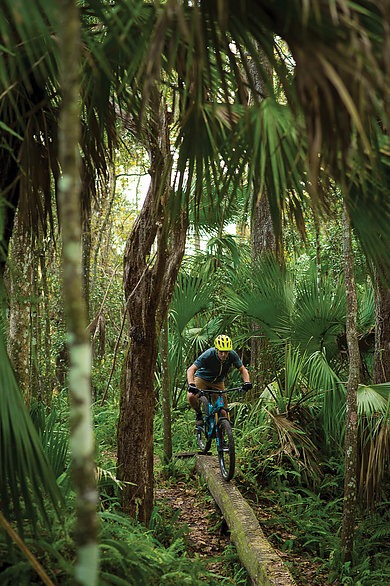
We pulled into our friends’ driveway in Brevard 17 hours later, our eyes bloodshot and legs seiz- ing from the 1,300-mile drive. It was November 29—my birthday. I had turned 46 somewhere in Maryland.
Our friends, Trish and Chad, were already in their bike clothes, ready to head toward Black Mountain Trail, one of Pisgah’s premier rides.
Chad even had his helmet on, as eager to get out as their dog Bob, but their preparedness had more to do with weather than excitement—the snowstorm that chased us out of Quebec was due to hit Brevard the next day. Temps were dropping as we reached the trailhead, and had hit freezing by the time we downed our first round of birthday microbrews at The Hub bike shop. By the second, snowflakes were beginning to fall.
I awoke the next morning to a hangover and three inches of snow on the van’s windshield. For a blurry moment, I was half-convinced we were still in our driveway. Then reality hit. We needed a new plan.
Chad and Trish presented an unusual option over espresso and homemade waffles: Florida, a place that conjured images of oranges and alliga- tors. But they insisted. “It’s warm, and there’s lots of good riding,” Chad said. That was all the con- vincing we needed.
A quick look at Trailforks made us even more optimistic—Florida had more than 1,000 trails, a few of which, we figured, had to be decent. After all, we just wanted vitamin D, and Florida’s nick- name is the Sunshine State. With snow piling up outside the windows, we said our goodbyes and once again drove south.
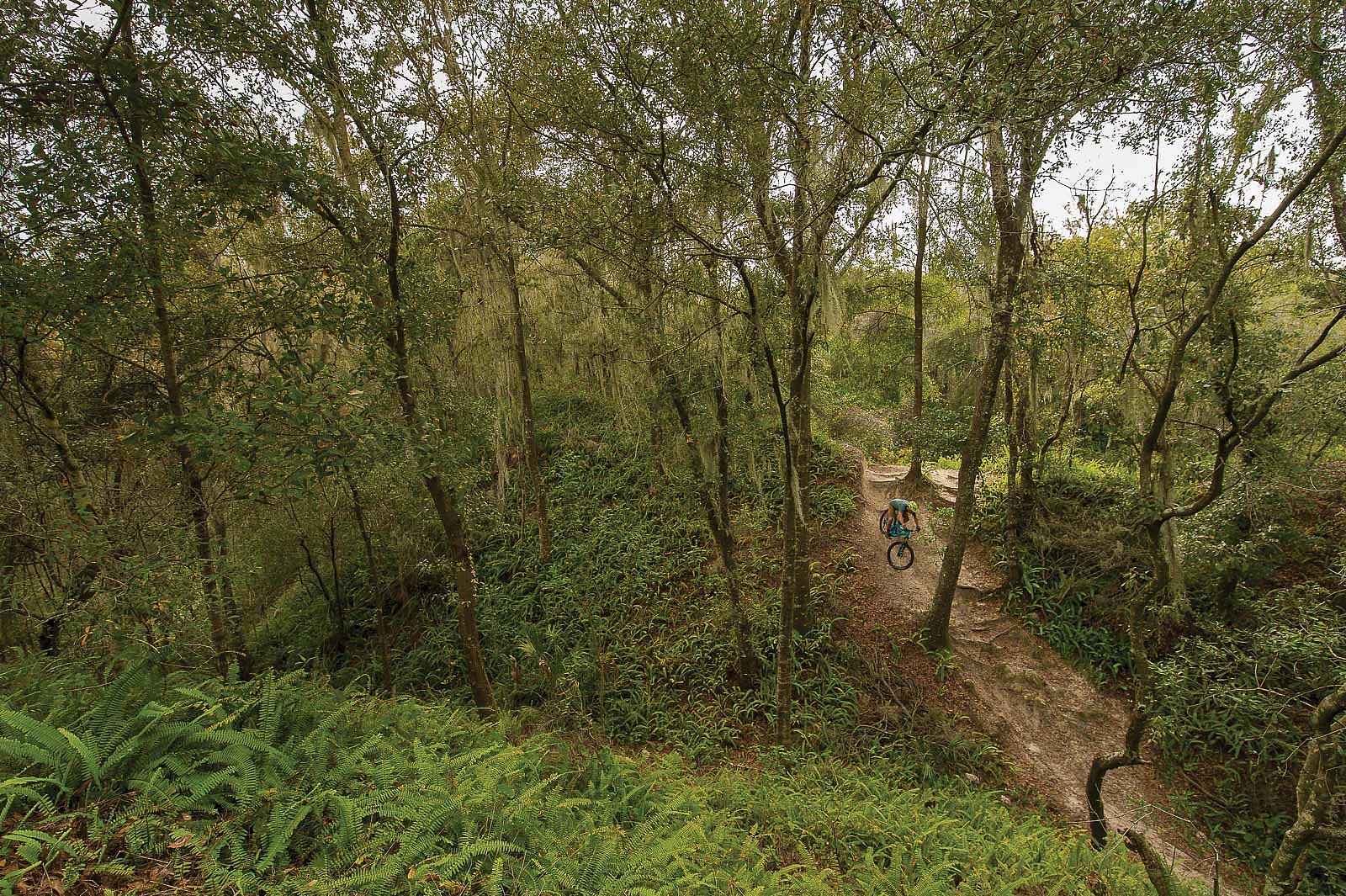
I knew we’d made a good choice after our first stop for gas in Florida. Fuel prices were nearly half what we’d found in North Carolina and, more importantly, we could finally wear our flip-flops.
As for the best place to don our bike shoes, that was less certain. The Santos Recreation Area seemed to be our most promising option. With more than 85 miles of singletrack, all developed and maintained by the volunteer-based Ocala Mountain Bike Association, it is the largest trail network in the state. So we aimed for our usual camping destination, the trailhead parking lot.
We were welcomed by a large sign: no camping in parking lot.
Luckily, the official Santos Trailhead Camp- ground was just down the road, complete with showers and firepits. The recreation area is a ma- jor stop on the Cross Florida Greenway, a 110-mile park that follows the failed Cross Florida Barge Canal, and sits upon a former African American town displaced by the construction efforts. The area’s historic baseball fields pay homage to the town’s residents—as for the canal, all that remains of the largest unfinished public-works project in history are a few decaying bridge supports.
Noticing our Quebec license plates, many greeted us with a hearty, “Bonjour! Bienvenue en Florida!” (it turns out Floridians love to practice their French), and all were surprised to hear we’d made the journey specifically to mountain bike.
The next morning, a steady stream of locals stopped by as we prepared our bikes. Noticing our Quebec license plates, many greeted us with a hearty, “Bonjour! Bienvenue en Florida!” (it turns out Floridians love to practice their French), and all were surprised to hear we’d made the journey specifically to mountain bike. Obviously proud of their trails, each visitor added to the lineup of the state’s “must ride” areas.
The list got very long, very quickly.
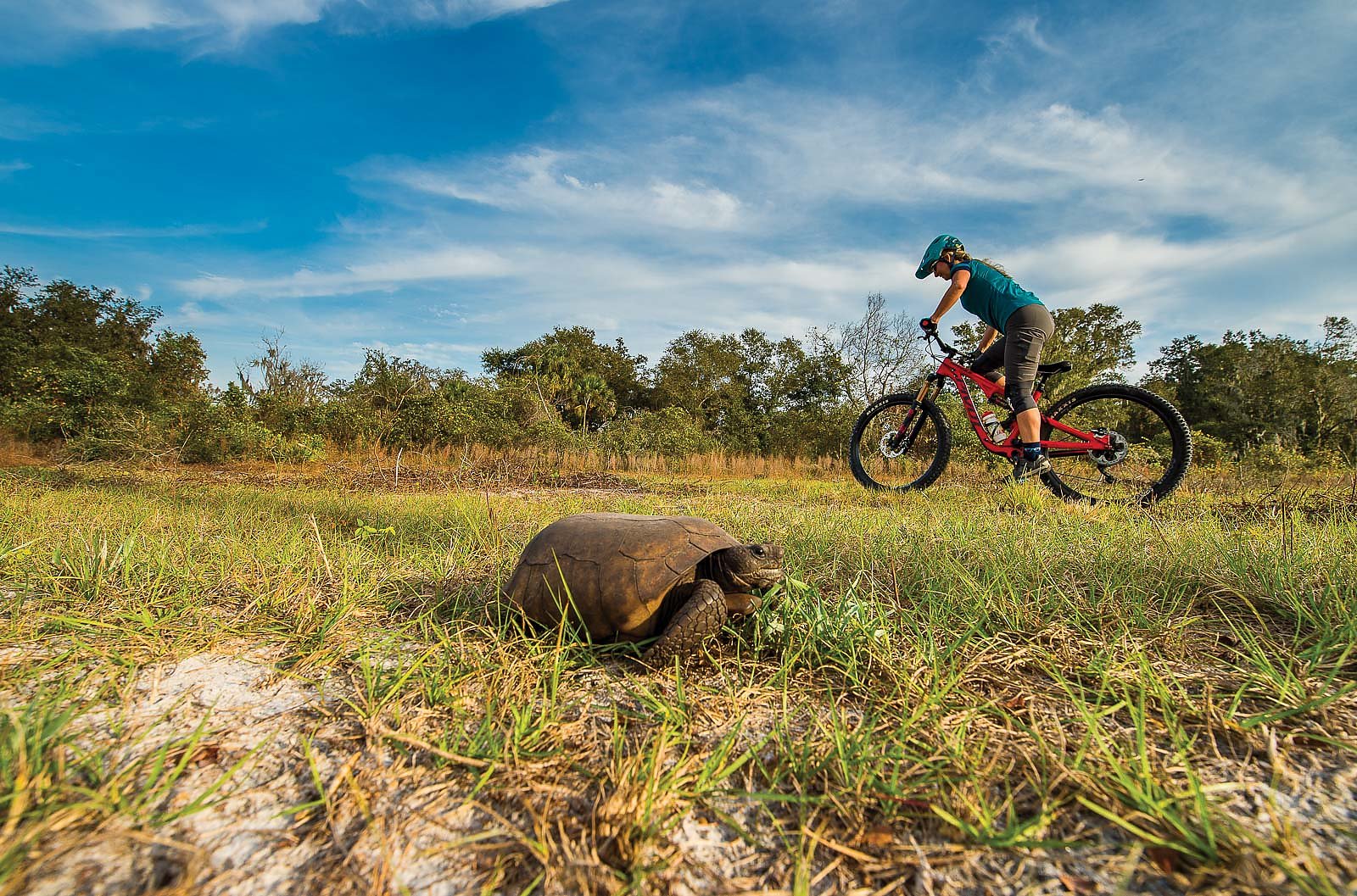
But first, Santos’ vast network beckoned from the forest. After 1,300 miles, we’d see what this flatland had to offer. With dark clouds on the horizon, we dropped in—and immediately entered a tropical jungle.
Diving and sweeping under vines and ferns, the trails twisted up onto wall-rides, fell away on steep drops, crossed green swamps on wooden bridges, and had equally fitting names like Vortex or Indigo Flow (named after a local snake that grows to more than eight feet long). We pedaled late into the afternoon and through a rainstorm, trying to take in as many trails as our legs and light would allow. Soaked to the bone and in need of dry socks, we finished our ride with a cold beer at nearby Green- way Bikes. Outside, the rain continued; it seemed we’d once again dragged storm clouds behind us. Hungry for sun and new terrain, we decided to head east. The beach was calling.
We pulled off the highway an hour later, navigating the van into the parking lot at De Leon Springs State Park. The park is best known for its namesake De Leon Spring, a round basin of clear water once dubbed the “Fountain of Youth.” For mountain bikers, the draw is the Chuck Lennon Trail network, some 10.5 miles of winding singletrack under a canopy of old-growth bald cypress trees that made for unreal photos and even weirder riding. It’s also packed with wildlife, as multiple Trailforks reports warned of a gator hanging around one of the skinnies.
While we avoided the rain, we were still coated with damp clay. With no one around—it was late afternoon on a weekday—we took advantage of the trailside wash station to hose off our bikes and our bodies. On the road, cleanliness is a luxury not to be wasted, especially when you’re headed to the beach.
Once again, however, the forecast changed our plans. Rain was still on our tail, and expected to hang around for a few days. Storm clouds and beach time don’t mix well, so we turned to our “must ride” list and started searching for places to escape the weather. Both west and north looked wet, but Alafia River State Park, just outside of the town Lithia, was forecasted to be warmer and dry. It’s also considered the hottest place to ride in Florida. South it was.
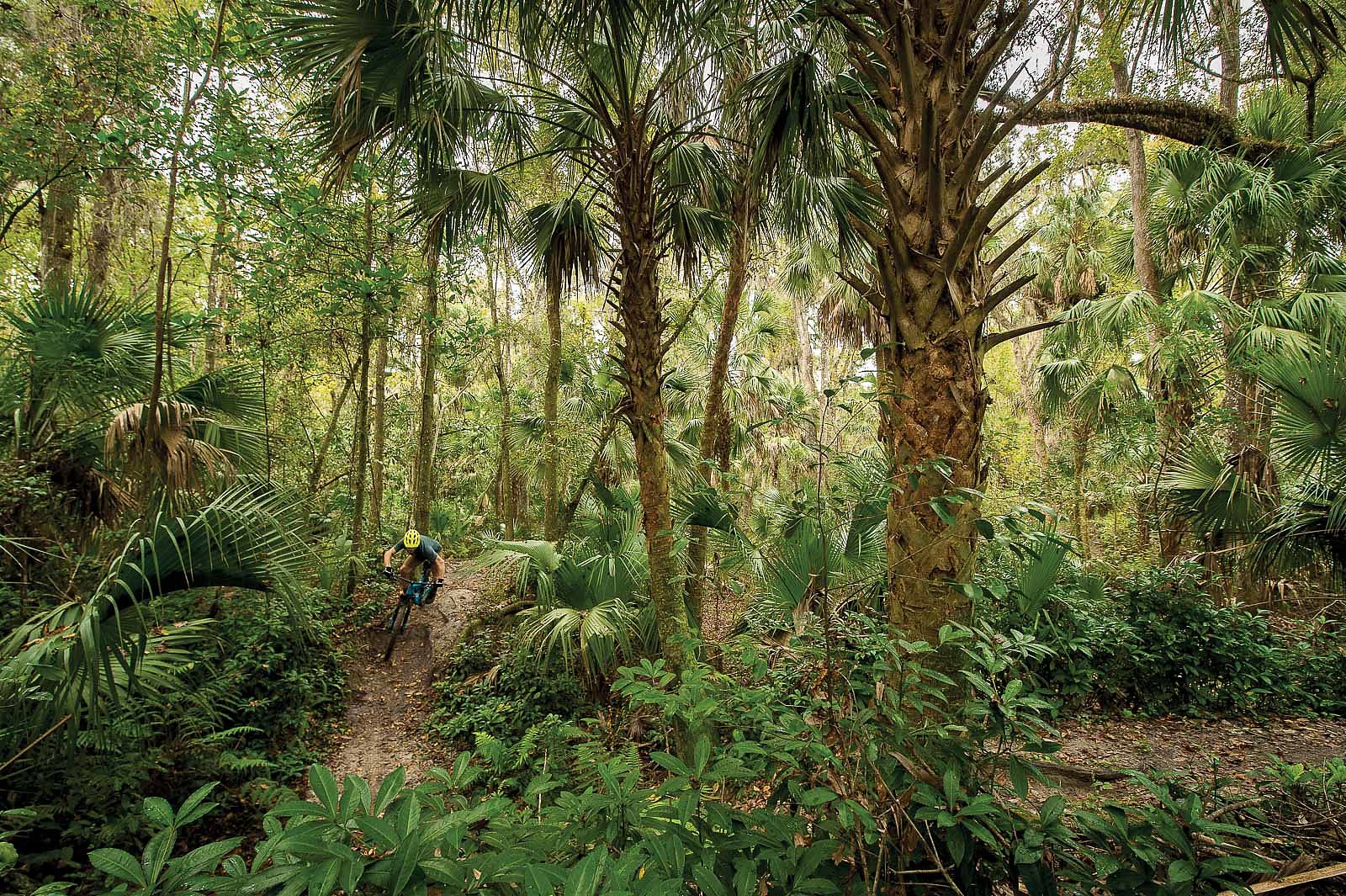
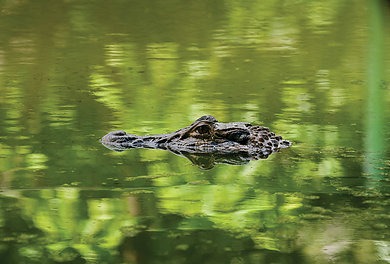
At first, we thought it was a joke. Or a metaphor. “Watch out for gators,” some locals at the trail- head warned us, “and don’t be surprised if one blocks the trail.”
Then we had our first alligator sighting, and realized the locals were being literal.
Located 10 miles southeast of Tampa, Alafia River State Park doesn’t have the most singletrack in Florida; there are some 20-plus miles within the park’s 7,733 acres. But those 20 miles are un- doubtedly the oddest. Swooping over, along and between a network of ridges and lakes, the Alafia trails are uncharacteristically steep for Florida—a bounty of vertical relief owed to the area’s location on an old phosphate strip mine.
As the miners dug holes and piled up extra dirt, they created a landscape akin to an Indiana Jones amusement ride complete with high-speed banked turns, high-exposure ridgelines and harrowingly steep descents, spread across trails with names like Gatorback, Moonscape and Rollercoaster. There’s even a swamp gap—especially frightening considering that coming up short could mean falling on a hungry alligator.
One day wasn’t enough for an Alafia tour, especially with the 23 miles of cross-country trails just down the road at the Balm Boyette Scrub Pre- serve. Looking to take a break from the steering wheel and put some miles behind our handle- bars, we posted up at a nearby campground and spent the next two days exploring. Though we saw plenty of gators lurking in the waterways, the only reptile to block our trail was a turtle.
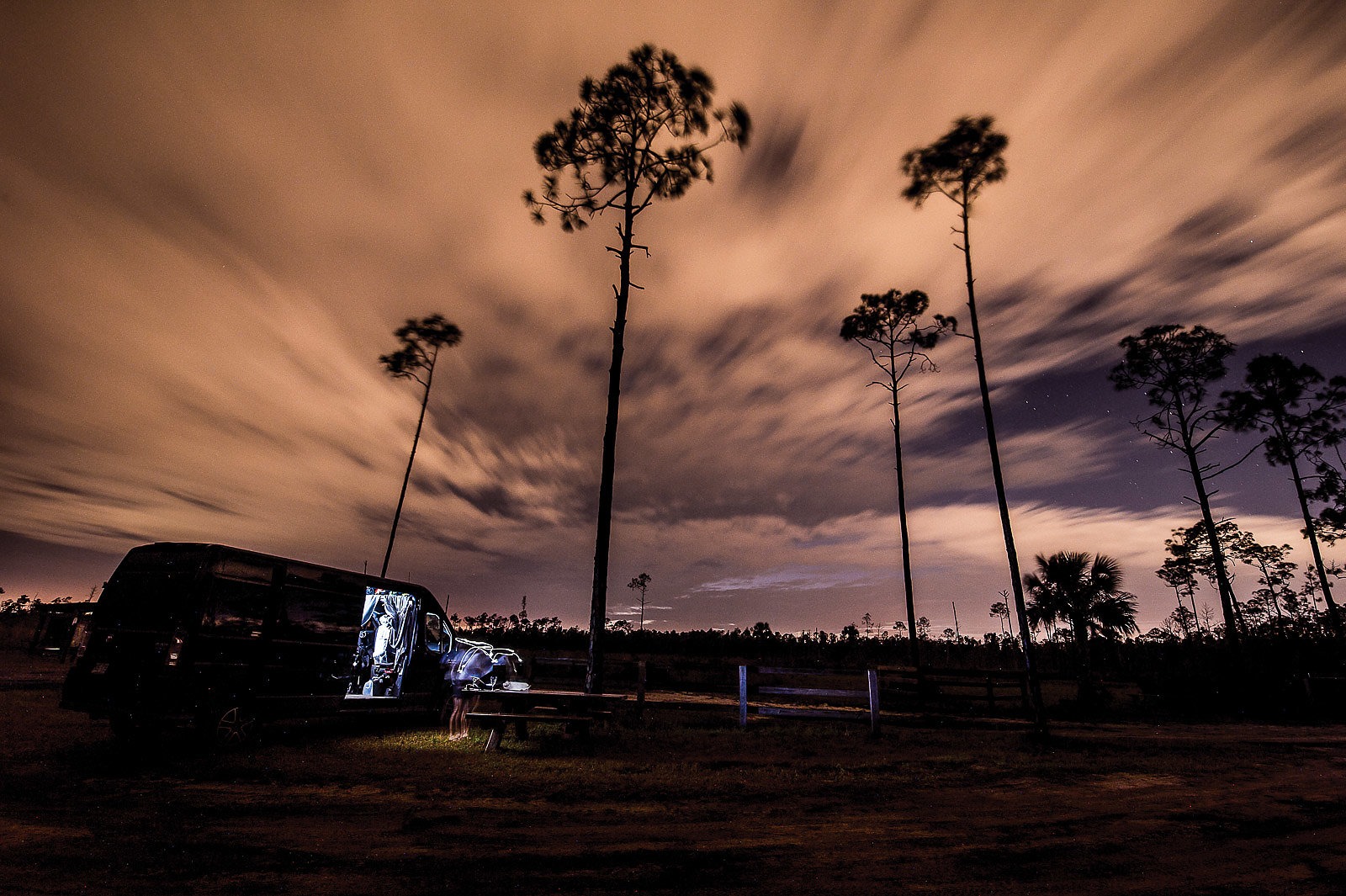
After two days in Alafia, it seemed the storm clouds finally decided to leave us alone. The “must ride” list, however, continued to grow with each local we met. With the weather clearing to the north and west, we reloaded the Black Rocket and set out to clear as many rides off our hit list as our legs would allow.
The next week took on a familiar rhythm: ride in the morning, eat lunch, then drive to a new trailhead. Following this schedule, we wandered through most of the southern and centrally located trail networks on our list, nearly all of which boasted excellent riding, whatever the size. Soon, however, we began to crave a rest day on the beach. It was time to go east.
Orlando was a snarl of traffic, and we decided to skip Disneyland and punch it toward New Smyrna Beach. We’d been told we “must ride” at Spruce Creek Reserve, a small networkof trails winding along the park’s circuitous waterways, and after busting out an eight-mile ride we bypassed the craziness of Daytona Beach toward our next destination: a giant swamp and more alligators.
Graham Swamp isn’t a promising name for a mountain bike trail, but several locals assured us it was one of the best in the state. Though only six miles long, it traverses a gauntlet of flowy berms, wood features, punchy climbs and pinner descents, all under a towering forest a short drive to the Atlantic coastline.
Just 10 miles up the coast was another “must ride” trail: Mala Compra, a mellower, relaxing stretch of singletrack. Mala Compra starts at the ocean and, after three weeks and 15 different trail systems, it marked the official end to our mountain bike tour.
It was time to make the long drive north, but before we started the 2,000-mile slog we decided to spend one more evening on the beach. What had started with a cold snap in October nearly 5,000 miles before finished on Decem- ber 22, with a sunset on a warm beach, sipping a summer cocktail and savoring a final dose of Florida sun.

